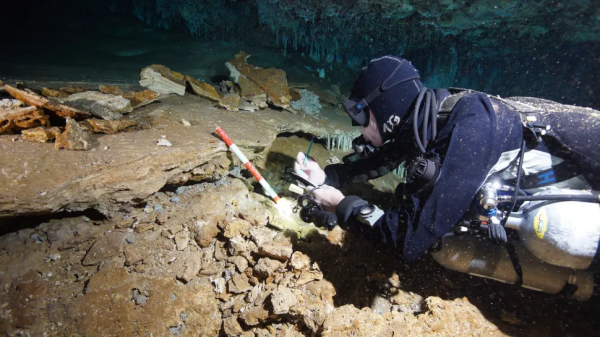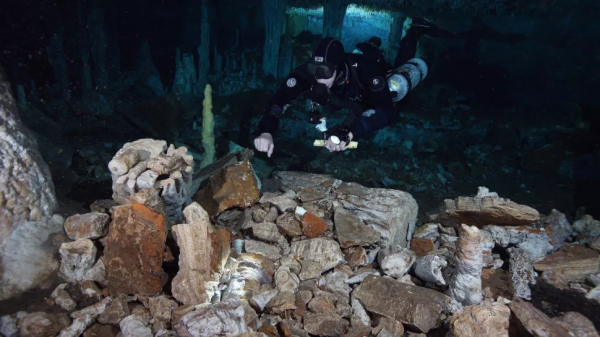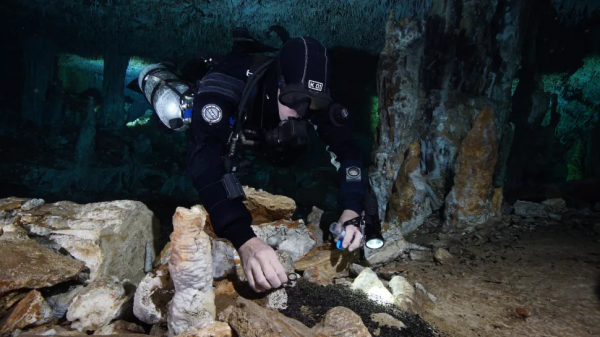Ice Age Mining Camp Found ‘frozen in time’ in Underwater Cave
Scientists have recently announced the discovery of an Ice Age cave system in Quintana Roo, Mexico on the Yucatan Peninsula.
In 2017 when Fred Devos, a diver with the Aquifer System Research Center of Quintana Roo found a previously unknown entrance they were able to access chambers never seen before.
The submerged caves, which are about two thousand feet deep, date back to the Paleoindian age, about twelve thousand years ago when the water level was lower and they were above water. Human presence has been discovered in three sites including Camilo Mina, Monkey Dust and Sagitario.
In these caves evidence of mining for ochre was found. Ochre is usually defined by archaeologists as any iron-rich rock that can be used as a pigment. Brittanica.com defines ochre as “a native earth colored with hydrated iron oxide that ranges in color from yellow to deep orange or brown.”

Red ochre is the most commonly identified paint used throughout history worldwide and is considered to be a key component of human evolutionary development, according to the research paper at advances.sciencemag.org.
The paper also claims that ochre mining was not limited to a few caves but caves over the entire region that were mined by generations of early humans.
The caves were dark and dangerous but there is abundant evidence that an entire mining camp had existed in the caves. Samuel Meacham, the founder of Aquifer System Research Center of Quintana Roo joined Devos for a dive where they found human skeletons, prospecting tools made from nearby rocks, carefully stacked debris and one hundred and fifty five stone cairns to guide the miners through the passageways.
They also found neatly stacked broken stalactites that may have been used to break the flowstone floor under which the ochre was found in three hundred and fifty two giant pits and trenches that lined the floors.

Another cave showed pieces of flowstone and limestone dug out but there was no further digging leading researchers to believe the ochre was not of good enough quality.
The researchers cannot be sure of how much ochre was extracted from the caves but with so many dig sites along the just over half mile distance of mining debris, the amount would have been substantial.
Lead author of the study, Dr. Brandi MacDonald, an assistant research professor at the Archaeometry Laboratory of the University of Missouri called the caves an underwater time capsule and remarked, “It’s a really rare opportunity to get to see something with such amazing preservation.”
The preservation is due to the still waters inside the caves that kept everything, including charred campfire pits exactly as it was twelve thousand years ago, according to advances.sciencemag.org.
The divers collected calcite crystals, ochre and charcoal which were tested. The ochre was of fine quality that would have produced a bright red color, but experts don’t clearly understand why so much effort was placed into mining the mineral.
It was already known that ochre was used for drawing, burials and ritualistic ceremonies and now they know it may have been used as a sunblock, an antiseptic, bug repellant and possibly for hide tanning.

The ochre was very high in arsenic at four thousand parts per million which McDonald says may be a clue that it was used as a bug repellant.
According to an e-mail sent to livescience.com, Dr. Mark Hubbe, a professor of anthropology at Ohio State University in Columbus remarked, “Early human groups in the Americas were already engaged in complex activities that went much beyond their own survival.
The mining of ochre from the caves suggest[s] that there was an important social meaning to this mineral and, even though we cannot really say what they were using this material for at this point, it does show it was immensely valuable and important for them.”
Another Article From Us: 2300-Year-Old Scythian Woman’s Boot Preserved in the Frozen Ground
Over twenty thousand photographs were taken over a period of ten three hour dives but it was too difficult to photograph some of the narrowest passages because of the lack of light. Excavations and study will continue at the Quintana Roo caves with many more discoveries waiting to be found.





